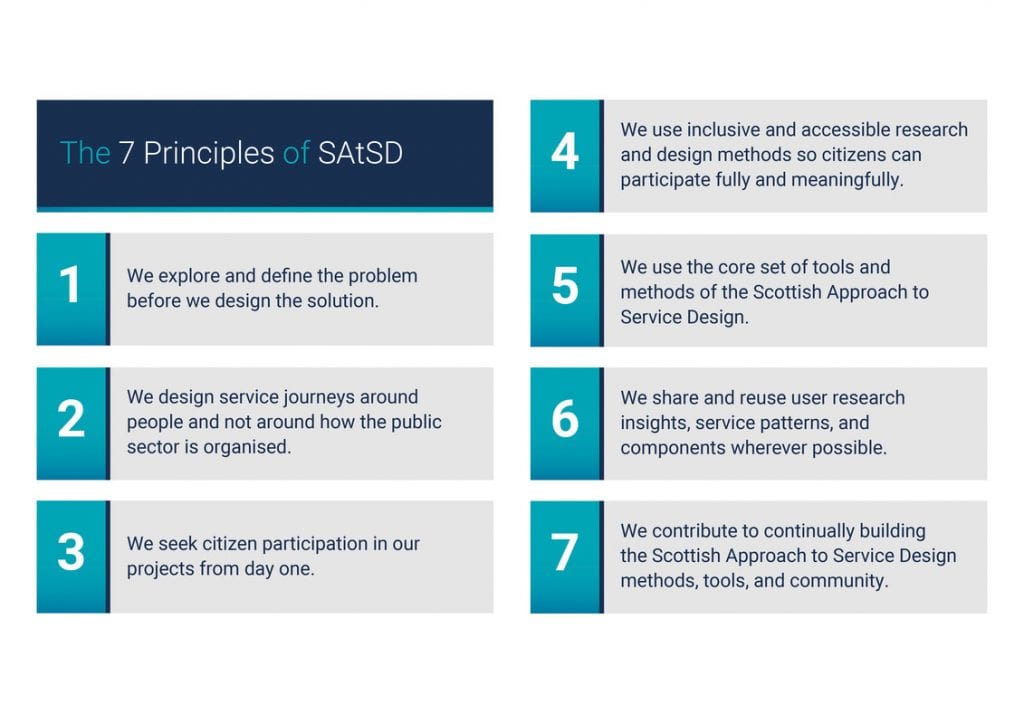Digital
Scottish Approach to Service Design: Creating Conditions for Change
July 3, 2019 by Kate Lyne No Comments | Category Digital Participation, Scottish Approach to Service Design, Uncategorized
This blog is by Dr Dhruv Sharma, User Reaserch Lead at the Scottish Government.
Amongst all the exciting stuff I do within Scottish Government’s Office of the Chief Designer, one crucial part of my job is replying to the question, “so, what does Scottish Approach to Service Design actually mean?”
Thankfully we now have the short and snappy ‘playbook’ to answer that question for us, so I now spend my time highlighting how we go about using it in our work, affecting change.
If you’ve never heard of it, then I’d recommend checking our playbook out. However, I’ll also try to summarise the key points here. As our Chief Design Officer, Cat Macaulay points out on Twitter, the Scottish Approach to Service Design (#SAtSD) is an attempt to create a shared, “collaborative way of designing public services in Scotland”.
Start with co-production
The story of the SAtSD begins with the publication of the Christie Commission on the Future Delivery of Public Services Report in 2011. Along with several other aspects of improving public service delivery, this report called out the role of co-production and utilising an asset-based approach when designing public services. According to this report, “asset-based approaches recognise that individuals and communities are a part of the solution and work with people rather than viewing them as passive recipients of services, and empower people to control their future”.
These values are at the heart of the SAtSD as we co-produce the approach with colleagues from:
· other parts of the Scottish Government
· the NHS
· the Third Sector
· the Local Government Digital Office
· other public and private sector bodies
The SAtSD argues that anyone who is involved in designing and delivering public services should spend more time exploring the problem they are trying to solve. This should be explored in an open and collaborative manner, with their users, before they start designing solutions.
Problems with this approach
You can read more about this in the playbook, but in line with this philosophy, our own mapping of this problem space shows that doing this kind of work in the public sector is actually quite difficult.
This is due to many different reasons but primarily because:
· there are currently no standard methods and tools for doing this
· we design services based on how our organisations are structured, rather than how users live their lives
· there is uneven capacity and capability across the public sector
Overcoming these problems
The SAtSD aims to create the conditions for change needed to transform public service design from being organisation-led to service user-led. At the Scottish Government, we know we have to come at it from both ends.
Firstly, we have to co-produce guidance, tools, and methods for organisations so they can collaborate more effectively around their users’ needs. This will help harness the strengths of an asset-based approach. Secondly, we have to make it easier for users to participate in shaping the services that affect them.
A playbook for organisations and practitioners
For organisations, we’ve now got the playbook. The current version has been developed to get senior-stakeholder buy-in and to raise awareness about user-centred design ways of working.
At the Office of the Chief Designer, we are busy creating a more detailed (practitioner’s) version to equip our colleagues with a common set of tools and practices that they can utilise in their work when designing public services.
The playbook acts as a gateway into this growing community of practitioners who are involved in shaping this as we go along.
Helping people take part
On the citizen end, we’re trying to make our own ways of working as inclusive and accessible as possible.
We are doing this by:
· simplifying our communications when we invite users to participate in our research and design activities
· ensuring the venues that we hire are accessible and suitably equipped to allow our disabled users to engage with us meaningfully
· providing users with enough information about the activities we plan to run, so they have a chance to envision any problems they may have, and we can find potential solutions to help them
These are just some of the things we are trying to encourage, enable and empower those designing public services and those using them. In doing so, we’re tapping into the innate creative abilities of people to come together and create a better, fairer Scotland where the SAtSD is everybody’s business.
Tags: 7 Principles of SAtSD, accessible, conditions for change, inlcusive, Office of the Chief Designer, playbook, SAtSD, Scottish Approach to Service Design, service design, user centred design, user research



Leave a comment